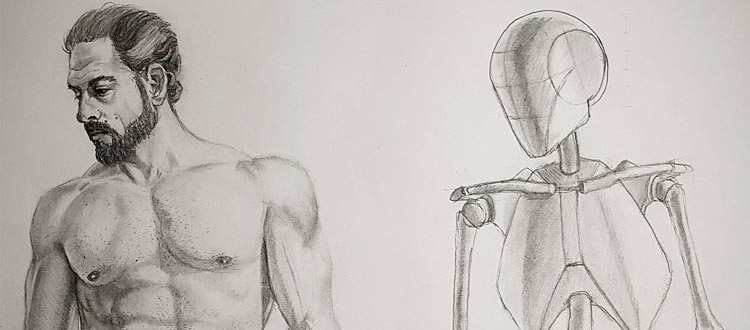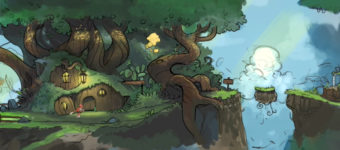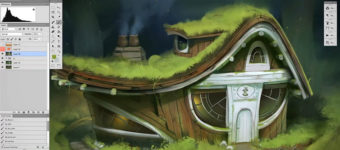
Digital vs. Traditional: What To Practice For Entertainment Art
Every concept artist must be able to work digitally. But new artists can learn a lot from traditional drawing materials which don’t offer the same shortcuts you get with digital tools.
Every serious entertainment artist should eventually move to digital art because it’s easier for painting and preferred by professionals. But if that’s the case, why even bother with traditional drawing at all?
I’d like to share some thoughts about the value of traditional skills and how they apply to modern work. Every field from concept artists to animators can learn a lot from working traditionally. These two mediums are not in competition with each other. They actually compliment one another.
Traditional Drawing Perks
I’ve read various opinion pieces on the topic of drawing tablets where some are glad they started early, and others would’ve liked to have more traditional experience.
The biggest perk of traditional art is that it’s not tied to electricity. Your art simply requires a pencil and some paper. You can draw at the park, on the bus, with a goat or on a boat. Or anywhere humorously Seussical.
It’s also easy to assume you’re progressing much quicker if you pick up a tablet too early. Drawing is hard for new artists and it takes time. This frustration can lead to just “moving on” even if you’d still benefit from more traditional studies.
Try to not invest much money into materials beyond the absolute basics at first.
Here’s a great quote from a Tuts+ piece written by Monika Zagrobelna:
Switching to a tablet and drawing software too soon may lead to a situation in which you’ll be very proficient at workarounds. You’ll be able to create anything, but it will not be really drawing. And it’s not that you can’t learn how to draw by using a tablet, but all these conveniences will make “classic” learning seem obsolete.
It may seem easier to jump into digital right away. But as a beginner you need to understand the basics of rough drawing and fixing mistakes. Pixels behave differently than graphite.
If you’re serious about art as a career then put some effort into traditional drawing for at least a few months before buying a tablet.
I can’t say tablets are bad; in fact they’re amazing. Never before in history has there been such a device that has so radically changed the process of creating & sharing art.
But new artists can fall off the beaten trail easily and conflate different methods together.

There’s no set time or skill level you must reach before going digital. Just be objective and willing to observe your skills as they advance. You’ll know when it’s time for a tablet because it’ll just feel right to move on.
Practicing As A Beginner
There are many reasons why beginners should fall in love with traditional drawing materials, but the biggest reason is simplicity.
It’s much easier to draw on paper with pencil rather than a tablet. It takes time adjusting to the tablet’s surface, the pen, and the technique of staring at the screen while you draw. We all know how to write on paper so we’re familiar with the action of moving a pencil across paper.
But another big reason is because it’s much cheaper to work traditional first. You can get a ream of printer paper for maybe $5. Art pencils can be pricey but certainly not enough to shatter your wallet.
Also I wanna state that there are cheap drawing tablets out there. The Intuos Draw and the Huion H610 are both very affordable for a new artist. But anyone taking digital art seriously will be quick to upgrade, so they may not serve a lengthy purpose.
Some artists choose to go with both methods practicing traditional and digital simultaneously. There’s certainly nothing wrong with this, although it may become overwhelming when you’re brand new and struggling to learn.
The biggest argument I’d have in favor of traditional work is that most professional artists can draw with a pencil. Most professionals carry sketchbooks and love to draw away from the computer screen.
There’s a tremendous world of digital art out there and it’s clearly much easier to paint digitally without any materials. But when first getting started consider the possibilities of traditional mediums and be willing to take a sketchbook with you to just get away from the computer.
Going Digital
The first thing you’ll realize about digital art is that it’s so much friendlier to painting. Instead of buying a palette with oils or watercolors you just open a design program like Photoshop and go to town.
However there is a big difference with drawing. It takes some time acclimating to the tablet’s sensitivity and pressure points. Whenever you draw on paper you’re typically looking at the paper(or sketchbook).
Unless you have a high-end tablet with a built-in LCD screen you’re probably drawing on the tablet and staring at the monitor. This can take a month or more to really get used to the behavior.
Even if you’re great at traditional drawing you may struggle when going digital. This is perfectly normal and should not freak you out. Check out this Stack thread for related answers on this topic.
I also recommend this post by Wacom covering tips & tricks for adjusting to a new tablet. You’ll want to rest your hand comfortably on the tablet as you draw. Treat it much like any other medium, but be careful how much pressure you’re applying at any given time.
There’s only so much that can be said about the switch to digital. Almost everything has to be learned through practice.
And it’s something you can’t avoid because tablets are necessary in the world of concept art. It’s just a matter of how soon you should pick one up, and how long it’ll take to become a natural part of your workflow.
If you’re looking for more tips on a tablet setup check out this handy guide written by Adam Wagner.
Picking Out A Tablet
Your first tablet is a very big decision. This will likely be one of the more expensive items you invest in, and it’s some proof of your dedication to the path of an artist.
But where should you start? Is it better to go super cheap or spend a little more upfront?
Try not to look at price as the ultimate deciding factor. You want to go with something that’s comfortable and affordable, but will be with you for a long time.
Many newer artists like the Parblo A610 with hot keys & a cheap price tag.
It’s actually much larger than a basic Wacom if you get the larger model.
Granted Parblo is a lesser-known brand so that may factor into your decision. Wacom is used in almost every professional industry by the majority of production studios across the globe. They have a long line of products and if you’re going for brand recognition then I’d say go Wacom.
The difficulty is picking one that suits your needs.
If you’re on a tight budget consider the Intuos Draw.
But if you’re willing to really get started in digital painting then go with the Wacom Intuos Pro medium. This measures at 15 x 10 inches so it’s definitely large enough, and it comes with 8 express keys on the side of the pad.
The Intuos Pro is actually the required tablet for studying at FZD School of Design in Singapore. The school is solely geared towards entertainment design & concept art with a heavy emphasis on digital drawing.
Take their recommendations with a grain of salt, but also look over the student work and skill progression. Yes this has a lot to do with their curriculum which you can read about here.
But either way that much progress is possible working on a single Intuos Pro in one year’s time. Although it’s really about the artist and not the tools.
But check out the drawing forums or the /r/Wacom subreddit if you have questions or want more suggestions for beginner tablets.
You really can’t go wrong with a first tablet, so whenever you’re ready just grab one and start going. It’ll always be a challenge at first. But if you already have some fundamental skills it’ll make the transition a lot smoother.












